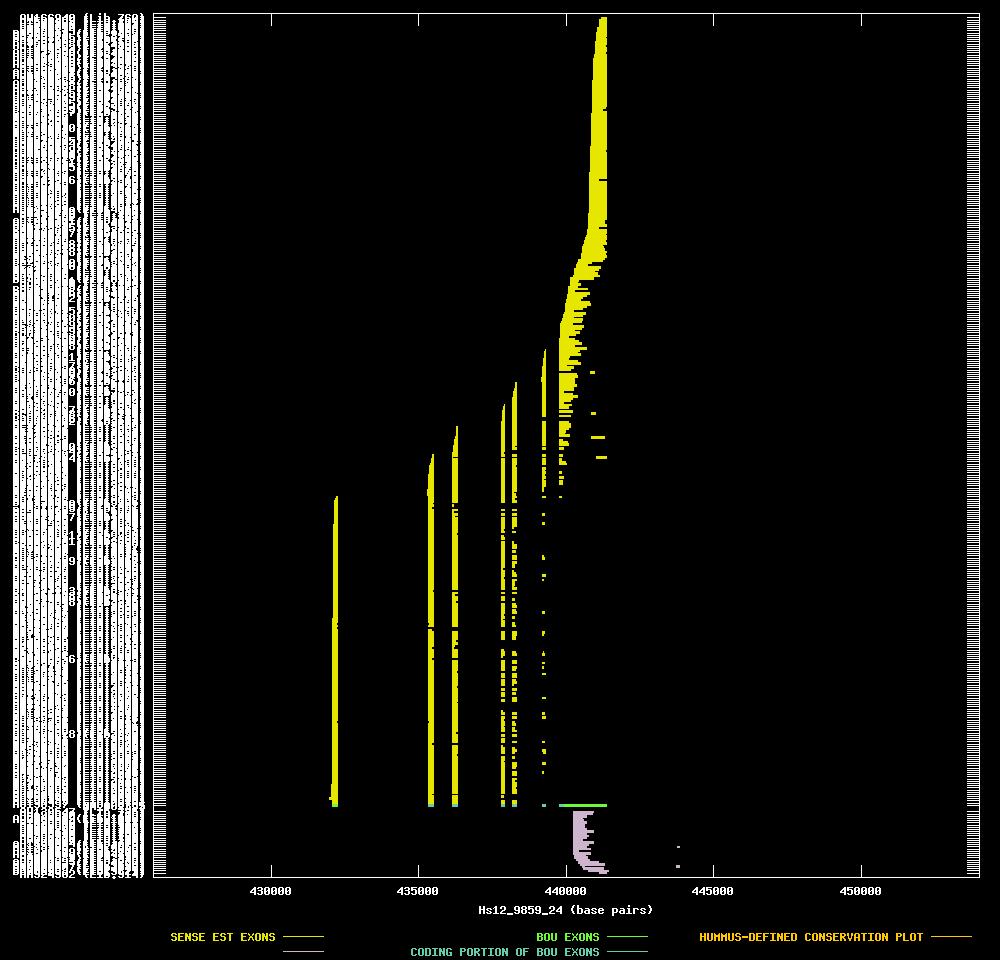



















| Candidate UniGene cluster: | UniGene Cluster Hs.75709 |
| Description: | mannose-6-phosphate receptor (cation dependent) |
| Best-Of-UniGene (BOU) Sequence | NM_002355 |
| Genomic Coordiantes Displayed: | Bases 426000 to 454000 of contig Hs12_9859_24 |
| BOU Orientation Along Contig: | LEFT-TO-RIGHT with respect to contig |
| Link to JPEG of genomic mapping | Hs.75709.jpeg |
| Best sense EST/protein match: | AU130322 matched ref|NP_002346.1| (NM_002355) cation-dependent mannose-6-phosphate receptor (E = e-99) |
| Best antisense EST/protein match: | No protein match with an e-value of less than 1e-10 |

ANTISENSE ESTs
| AW130547 | cDNA clone IMAGE:2621715 | stomach | 3' read |  | ||
| AW192536 | cDNA clone IMAGE:2677732 | pancreas | 3' read |  | ||
| R45234 | cDNA clone IMAGE:35189 | brain | 3' read | 1.9 kb |  | |
| AW078486 | cDNA clone IMAGE:2576677 | 2 pooled wilms' tumors, one primary and one metastatic to | 3' read |  | ||
| N94324 | cDNA clone IMAGE:309422 | 3' read |  | |||
| AI273890 | cDNA clone IMAGE:1964290 | ovary | 3' read | 2.5 kb |  | |
| AI749574 | cDNA clone IMAGE:2373547 | colon | 3' read |  | ||
| AW051209 | cDNA clone IMAGE:2557572 | uterus | 3' read |  | ||
| AW169295 | cDNA clone IMAGE:2657912 | uterus | 3' read |  | ||
| AI956148 | cDNA clone IMAGE:2509480 | pancreas | 3' read |  | ||
| AI963013 | cDNA clone IMAGE:2508559 | uterus | 3' read | 0.5 kb |  | |
| AW439285 | cDNA clone IMAGE:2778824 | uterus | 3' read |  | ||
| AW090406 | cDNA clone IMAGE:2590729 | brain | 3' read |  | ||
| F03237 | cDNA clone c1qf04 | brain | 3' read |  | ||
| AI888684 | cDNA clone IMAGE:2447347 | stomach | 3' read | 3.2 kb |  | |
| AU152962 | cDNA clone NT2RP3002094 | 3' read |  | |||
| AU144205 | cDNA clone HEMBA1001214 | whole embryo, mainly head | 3' read |  | ||
| AU149418 | cDNA clone NT2RM4002274 | 3' read |  | |||
| AI571509 | cDNA clone IMAGE:2225080 | pancreas | 3' read |  | ||
| AU151693 | cDNA clone NT2RP2005866 | 3' read |  | |||
| H69929 | cDNA clone IMAGE:239205 | nose | 3' read | |||
| AA179832 | cDNA clone IMAGE:613186 | 3' read | ||||
| AA700293 | cDNA clone IMAGE:460745 | pool | 3' read | |||
| AV708082 | cDNA clone ADCAPD02 | adrenal gland | 5' read | |||
| BE909007 | cDNA clone IMAGE:3899824 | epithelioid carcinoma | 5' read | |||
| AA285307 | cDNA clone (no-name) | 5' read |